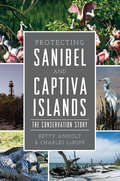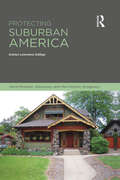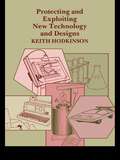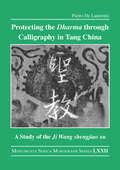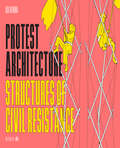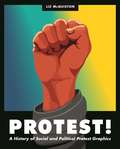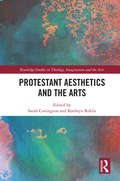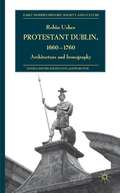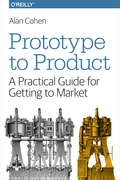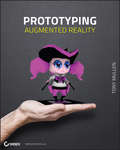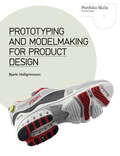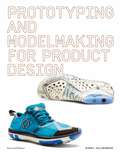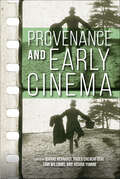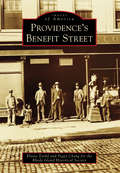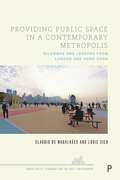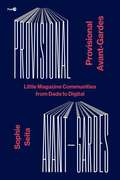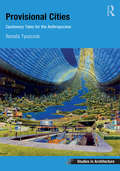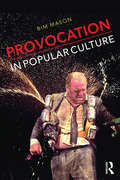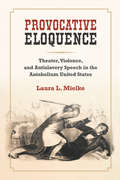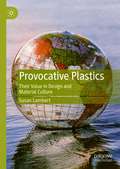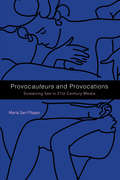- Table View
- List View
Protecting Buildings From Bomb Damage: Transfer of Blast-Effects Mitigation Technologies from Military to Civilian Applications
by National Research CouncilThis book provides a brief overview of worldwide terrorist activity and reviews technologies and methods for designing blast resistant buildings. These techniques, primarily developed by the military, have applicability and relevance to the design of civilian structures. The volume recommends that a program of applied research and technology transfer be undertaken to hasten the availability and utility of these techniques to the civilian building community.
Protecting Sanibel and Captiva Islands: The Conservation Story (Natural History)
by Betty Anholt Charles LeBuffThe vibrant Sanibel and Captiva Islands are ecological marvels compared to Florida's many overbuilt barrier islands. Development began with the construction of the Sanibel Island Lighthouse in 1884, when only the lighthouse keeper and assistant and their families lived on the island. Noted conservationist Jay N. "Ding" Darling led the charge in preserving the islands' wildlife and natural beauty from the greed of real estate speculators and land developers in the 1930s. Former presidents like Harry Truman and cabinet-level executives worked alongside Sanibel and Captiva residents, setting up preserves and wildlife refuges to guard the integrity of the islands' unique natural blessings, abundant wildlife and aquatic stores. Charles LeBuff and Betty Anholt review the evolution of the islands' conservation ethic and how it perseveres even today.
Protecting Suburban America: Gentrification, Advocacy and the Historic Imaginary
by Denise Lawrence-ZunigaProtecting Suburban America explores the dynamics and conflicts inherent in preserving historic twentieth-century suburban landscapes in America.Bridging architecture, anthropology, planning, and urban studies, its unique approach combines a study of historic preservation with multi-sited ethnographic fieldwork, to shed fascinating light on issues of heritage, preservation, gentrification, class, ethnicity, and contested values in suburbia. These are subjects which reach far beyond the setting of the book’s focus in California to touch on topical debates in cities, suburbia, and gentrifying neighborhoods worldwide.At the heart of the book is a detailed comparative ethnography of preservation practices and the changing landscapes of five suburban cities, where affluent homeowners have begun to restore their early twentieth-century houses in neighborhoods once suffering from decline. Not every neighbor, however, shares the same aesthetic values, and complex dynamics can arise. The study compares experiences in five different cities, and in different long-term, immigrant, and gentrifying populations. Themes revealed include homeowner restoration practices, aesthetic contestations, local advocacy, and public policy, alongside an exploration of the social construction of the historic restoration process, and how homeowners construct ‘historical’ meaning in their homes and neighbourhoods. These are themes with consequences for national and global settings – of interest wherever contested preservation aesthetics and regulations are reshaping older residential neighbourhoods and their social dynamics.
Protecting and Exploiting New Technology and Designs
by K. HodkinsonThe protection of intellectual property rights has become a major concern in recent years. The opportunities being seized, or lost, in areas such as computer software or biotechnology have captured most of the headlines but in every research facility, whatever the subject, there is an increased awareness of the importance to R & D management of a more commercial attitude. Keith Hodkinson has run Government sponsored "professional updating" courses for academic and industrial researchers and business executives. The practical questions raised there and the advice found most useful have all helped to make this guide a down-to-earth source of help which will be of immediate, profitable use to its readers. Appendices to the book as well as giving lists of useful names and addresses to contact also contain examples of draft letters, contracts and record forms and licensing negotiating checklists.
Protecting the Dharma through Calligraphy in Tang China: A Study of the Ji Wang shengjiao xu 集王聖教序 The Preface to the Buddhist Scriptures Engraved on Stone in Wang Xizhi’s Collated Characters (Monumenta Serica Monograph Series)
by Pietro De LaurentisThis is a study of the earliest and finest collated inscription in the history of Chinese calligraphy, the Ji Wang shengjiao xu 集王聖教序 (Preface to the Sacred Teaching Scriptures Translated by Xuanzang in Wang Xizhi’s Collated Characters), which was erected on January 1, 673. The stele records the two texts written by the Tang emperors Taizong (599–649) and Gaozong (628–683) in honor of the monk Xuanzang (d. 664) and the Buddhist scripture Xin jing (Heart Sutra), collated in the semi-cursive characters of the great master of Chinese calligraphy, Wang Xizhi (303–361). It is thus a Buddhist inscription that combines Buddhist authority, political power, and artistic charm in one single monument. The present book reconstructs the multifaceted context in which the stele was devised, aiming at highlighting the specific role calligraphy played in the propagation and protection of Buddhism in medieval China.
Protest Architecture: Structures of civil resistance
by Nick NewmanA complex bamboo pyramid to block a busy crossing in London. A maze of 'mini Stonehenge' brick structures to hinder government crackdowns in Hong Kong. The takeover of a Dallas highway to create a temporary public square.Architects have often used their skills in struggles for civil rights, gender equality and climate justice. Illuminating the role that design has played in protest movements, Nick Newman explores the colliding worlds of architecture and activism through the stories of those who have built for change.Using historic and contemporary examples, Protest Architecture analyses the design problems and solutions faced by protestors on the streets through detailed drawings, photography and expert insight.From beacons to barricades, towers to treehouses, this unique design typology demonstrates architectural influence over moments of societal change.This is a retelling of protest history through the eyes of an architect.
Protest!: A History of Social and Political Protest Graphics
by Liz McQuistonAn authoritative, richly illustrated history of six centuries of global protest artThroughout history, artists and citizens have turned to protest art as a means of demonstrating social and political discontent. From the earliest broadsheets in the 1500s to engravings, photolithographs, prints, posters, murals, graffiti, and political cartoons, these endlessly inventive graphic forms have symbolized and spurred on power struggles, rebellions, spirited causes, and calls to arms. Spanning continents and centuries, Protest! presents a major new chronological look at protest graphics.Beginning in the Reformation, when printed visual matter was first produced in multiples, Liz McQuiston follows the iconic images that have accompanied movements and events around the world. She examines fine art and propaganda, including William Hogarth’s Gin Lane, Thomas Nast’s political caricatures, French and British comics, postcards from the women’s suffrage movement, clothing of the 1960s counterculture, the anti-apartheid illustrated book How to Commit Suicide in South Africa, the “Silence=Death” emblem from the AIDS crisis, murals created during the Arab Spring, electronic graphics from Hong Kong’s Umbrella Revolution, and the front cover of the magazine Charlie Hebdo. Providing a visual exploration both joyful and brutal, McQuiston discusses how graphics have been used to protest wars, call for the end to racial discrimination, demand freedom from tyranny, and satirize authority figures and regimes.From the French, Mexican, and Sandinista revolutions to the American civil rights movement, nuclear disarmament, and the Women’s March of 2017, Protest! documents the integral role of the visual arts in passionate efforts for change.
Protestant Aesthetics and the Arts (Routledge Studies in Theology, Imagination and the Arts)
by Sarah Covington Kathryn ReklisThe Reformation was one of the defining cultural turning points in Western history, even if there is a longstanding stereotype that Protestants did away with art and material culture. Rather than reject art and aestheticism, Protestants developed their own aesthetic values, which Protestant Aesthetics and the Arts addresses as it identifies and explains the link between theological aesthetics and the arts within a Protestant framework across five-hundred years of history. Featuring essays from an international gathering of leading experts working across a diverse set of disciplines, Protestant Aesthetics and the Arts is the first study of its kind, containing essays that address Protestantism and the fine arts (visual art, music, literature, and architecture), and historical and contemporary Protestant theological perspectives on the subject of beauty and imagination. Contributors challenge accepted preconceptions relating to the boundaries of theological aesthetics and religiously determined art; disrupt traditional understandings of periodization and disciplinarity; and seek to open rich avenues for new fields of research. Building on renewed interest in Protestantism in the study of religion and modernity and the return to aesthetics in Christian theological inquiry, this volume will be of significant interest to scholars of Theology, Aesthetics, Art and Architectural History, Literary Criticism, and Religious History.
Protestant Dublin, 1660–1760
by Robin UsherRobin Usherprovides a unique and comprehensive overview of the symbolic infrastructure of the official, Protestant city of Dublin from the Restoration of 1660 down to the middle of the eighteenth century. Through such monuments as churches, statues, government offices and townhouses, as well as the ephemera of public ceremonial, Usher showshow the early-modern urban populace made sense of its institutions, its localities, its amenities, and, indeed, its wider physical and mental worlds. Questioning faddish claims that seventeenth- and eighteenth-century Dublin can be interpreted as 'colonial' in its symbolic meanings, Usher adopts a trans-national perspective, arguing that the cultural horizons of the city's Protestant elites were as much European as British. Protestant Dublincombines anaccessible writingstyle with rigorous archival researchto appeal to anyone with a serious interest in how past societies engaged with the built environment.
Prototype to Product: A Practical Guide for Getting to Market
by Alan CohenProduct development is the magic that turns circuitry, software, and materials into a product, but moving efficiently from concept to manufactured product is a complex process with many potential pitfalls. This practical guide pulls back the curtain to reveal what happens—or should happen—when you take a product from prototype to production.For makers looking to go pro or product development team members keen to understand the process, author Alan Cohen tracks the development of an intelligent electronic device to explain the strategies and tactics necessary to transform an abstract idea into a successful product that people want to use.Learn 11 deadly sins that kill product development projectsGet an overview of how electronic products are manufacturedDetermine whether your idea has a good chance of being profitableNarrow down the product’s functionality and associated costsGenerate requirements that describe the final product’s detailsSelect your processor, operating system, and power sourcesLearn how to comply with safety regulations and standardsDive into development—from rapid prototyping to manufacturingAlan Cohen, a veteran systems and software engineering manager and lifelong technophile, specializes in leading the development of medical devices and other high-reliability products. His passion is to work with engineers and other stakeholders to forge innovative technologies into successful products.
Prototyping Augmented Reality
by Tony MullenLearn to create augmented reality apps using Processing open-source programming language Augmented reality (AR) is used all over, and you may not even realize it. Smartphones overlay data onto live camera views to show homes for sale, restaurants, or historical sites. American football broadcasts use AR to show the invisible first-down line on the field to TV viewers. Nike and Budweiser, among others, have used AR in ads. Now, you can learn to create AR prototypes using 3D data, Processing open-source programming language, and other languages. This unique book is an easy-to-follow guide on how to do it. Guides you through the emerging technology of Augmented Reality (AR) Shows you how to use 3D data with the Processing programming environment and other languages to create AR prototypes for the web, smartphones, Macs, and PCs Helps 3D artists and designers who want to move into the AR market but don't have programming skills Covers the essentials of 3D programming, creating objects for an AR library, building and exporting 3D models, and much more Explains how to interactively link 3D to physical, virtual, and streaming environments Author Tony Mullen is both an artist and a programmer and perfectly suited to explain how to bridge these two worlds, as he so deftly does in Prototyping with Augmented Reality.
Prototyping and Modelmaking for Product Design: Second Edition
by Bjarki HallgrimssonBuilding prototypes and models is an essential component of any design activity. Modern product development is a multi-disciplinary effort that relies on prototyping in order to explore new ideas and test them sufficiently before they become actual products. Prototyping and Modelmaking for Product Designers illustrates how prototypes are used to help designers understand problems better, explore more imaginative solutions, investigate human interaction more fully and test functionality so as to de-risk the design process. Following an introduction on the purpose of prototyping, specific materials, tools and techniques are examined in detail, with step-by-step tutorials and industry examples of real and successful products illustrating how prototypes are used to help solve design problems. Workflow is also discussed, using a mixture of hands-on and digital tools. A comprehensive modern prototyping approach is crucial to making informed design decisions, and forms a strategic part of a successful designer's toolkit.
Prototyping and Modelmaking for Product Design: Second Edition
by Bjarki HallgrimssonNow in its second edition, Prototyping and Modelmaking for Product Design, by practising product development consultant Bjarki Hallgrimsson, is essential reading for both students and design professionals.Prototyping and ModelMaking for Product Design goes behind the scenes to illustrates how prototypes are used to help designers understand problems better, explore more imaginative solutions, investigate human interaction more fully and test functionality so as to de-risk the design process. Following an introduction on the purpose of prototyping, specific materials, tools and techniques are examined in detail, with step-by-step tutorials and industry examples of real and successful products illustrating how prototypes are used to help solve design problems. Workflow is also discussed, using a mixture of hands-on and digital tools.This new edition includes case studies representing technological developments such as prototyping user experience and interactive electronic products, as well as a new expanded section on digital modelmaking tools, including 3D printing and laser cutting.The first chapters of the book explain why prototyping is so important to the design process. The many uses of prototyping will be shown in the context of several comprehensive projects by some of the world's leading design firms.The second part is an introduction to the typical materials used by designers in their prototyping efforts and how to work with them. In all cases, the approach is to use digital and manual tools in a complementary and effective fashion. Tutorials were specifically developed that underline the back and forth of digital and manual ways of working. The emphasis is on the kinds of construction that can be done by the designers themselves. Health and safety is stressed in terms of personal responsibility and awareness.Topics covered include:Definition of prototyping and modelmakingPrototyping as a form of problem solvingModelmakingPhysical and digital prototypesBuidling by hand and using digital technologies
Prototyping and Modelmaking for Product Design: Second Edition
by Bjarki HallgrimssonNow in its second edition, Prototyping and Modelmaking for Product Design, by practising product development consultant Bjarki Hallgrimsson, is essential reading for both students and design professionals.Prototyping and ModelMaking for Product Design goes behind the scenes to illustrates how prototypes are used to help designers understand problems better, explore more imaginative solutions, investigate human interaction more fully and test functionality so as to de-risk the design process. Following an introduction on the purpose of prototyping, specific materials, tools and techniques are examined in detail, with step-by-step tutorials and industry examples of real and successful products illustrating how prototypes are used to help solve design problems. Workflow is also discussed, using a mixture of hands-on and digital tools.This new edition includes case studies representing technological developments such as prototyping user experience and interactive electronic products, as well as a new expanded section on digital modelmaking tools, including 3D printing and laser cutting.The first chapters of the book explain why prototyping is so important to the design process. The many uses of prototyping will be shown in the context of several comprehensive projects by some of the world's leading design firms.The second part is an introduction to the typical materials used by designers in their prototyping efforts and how to work with them. In all cases, the approach is to use digital and manual tools in a complementary and effective fashion. Tutorials were specifically developed that underline the back and forth of digital and manual ways of working. The emphasis is on the kinds of construction that can be done by the designers themselves. Health and safety is stressed in terms of personal responsibility and awareness.Topics covered include:Definition of prototyping and modelmakingPrototyping as a form of problem solvingModelmakingPhysical and digital prototypesBuidling by hand and using digital technologies
Prototyping and Modelmaking for Product Design: Second Edition (essential Reading For Students And Design Professionals, Digital Processes, 3d Printing, Product Development)
by Bjarki HallgrimssonBuilding prototypes and models is an essential component of any design activity. Modern product development is a multi-disciplinary effort that relies on prototyping in order to explore new ideas and test them sufficiently before they become actual products. Prototyping and Modelmaking for Product Designers illustrates how prototypes are used to help designers understand problems better, explore more imaginative solutions, investigate human interaction more fully and test functionality so as to de-risk the design process. Following an introduction on the purpose of prototyping, specific materials, tools and techniques are examined in detail, with step-by-step tutorials and industry examples of real and successful products illustrating how prototypes are used to help solve design problems. Workflow is also discussed, using a mixture of hands-on and digital tools. A comprehensive modern prototyping approach is crucial to making informed design decisions, and forms a strategic part of a successful designer's toolkit.
Provenance and Early Cinema (Early Cinema in Review: Proceedings of Domitor)
by Joanne Bernardi, Paolo Cherchi Usai, Tami Williams and Joshua YumibeRemnants of early films often have a story to tell. As material artifacts, these film fragments are central to cinema history, perhaps more than ever in our digital age of easy copying and sharing. If a digital copy is previewed before preservation or is shared with a researcher outside the purview of a film archive, knowledge about how the artifact was collected, circulated, and repurposed threatens to become obscured. When the question of origin is overlooked, the story can be lost. Concerned contributors in Provenance and Early Cinema challenge scholars digging through film archives to ask, "How did these moving images get here for me to see them?" This volume, which features the conference proceedings from Domitor, the International Society for the Study of Early Cinema, 2018, questions preservation, attribution, and patterns of reuse in order to explore singular artifacts with long and circuitous lives.
Providence's Benefit Street (Images of America)
by Peggy Chang Elyssa Tardif Rhode Island Historical SocietyOfficially established by 1772 for "the benefit of all," Benefit Street is arguably the most historic thoroughfare in Rhode Island. Some of Providence's most prominent families, including the Browns (the namesake of Brown University), built stately homes on Benefit Street's hillside, many of which still stand today. Threatened by years of neglect, the Providence Preservation Society intervened in the 1950s to save the buildings that line the street. Benefit Street has survived the dangers of demolition and now bears witness to disparate time periods and communities. It is the site of important educational and community institutions, including the Rhode Island School of Design, Brown University, the First Baptist Church, and the Providence Athenaeum, the fourth oldest library in the United States. Providence's Benefit Street showcases the rich history of Rhode Island's capital, a tangible history that can be experienced firsthand by walking one mile through the heart of the city.
Providing Public Space in a Contemporary Metropolis: Dilemmas and Lessons from London and Hong Kong (Urban Policy, Planning and the Built Environment)
by Louie Sieh Claudio De MagalhãesIncreasingly, public space provision and management are being transferred from the public sector to real estate developers, private sector organisations, voluntary groups and community bodies. Contrasting the more historical, horizontal character of London with the intense street life of high-rise Hong Kong, this book tells the story of the two cities’ relationships with non-traditional forms of public space governance. The authors consider the implications for the ‘publicness’ of these complex spaces and the challenges and impacts that different forms of provision have on those with a stake in them, and on the cities as a whole.
Provisional Avant-Gardes: Little Magazine Communities from Dada to Digital (Post*45)
by Sophie SeitaWhat would it mean to be avant-garde today? Arguing against the notion that the avant-garde is dead or confined to historically "failed" movements, this book offers a more dynamic and inclusive theory of avant-gardes that accounts for how they work in our present. Innovative in approach, Provisional Avant-Gardes focuses on the medium of the little magazine—from early Dada experiments to feminist, queer, and digital publishing networks—to understand avant-gardes as provisional and heterogeneous communities. Paying particular attention to neglected women writers, artists, and editors alongside more canonical figures, it shows how the study of little magazines can change our views of literary and art history while shedding new light on individual careers. By focusing on the avant-garde's publishing history and group dynamics, Sophie Seita also demonstrates a new methodology for writing about avant-garde practice across time, one that is applicable to other artistic and non-artistic communities and that speaks to contemporary practitioners as much as scholars. In the process, she addresses fundamental questions about the intersections of aesthetic form and politics and about what we consider to be literature and art.
Provisional Cities: Cautionary Tales for the Anthropocene (Ashgate Studies in Architecture)
by Renata TyszczukThis book considers the provisional nature of cities in relation to the Anthropocene – the proposed geological epoch of human-induced changes to the Earth system. It charts an environmental history of curfews, admonitions and alarms about dwelling on Earth. ‘Provisional cities’ are explored as exemplary sites for thinking about living in this unsettled time. Each chapter focuses on cities, settlements or proxy urbanisations, including past disaster zones, remote outposts in the present and future urban fossils. The book explores the dynamic, changing and contradictory relationship between architecture and the global environmental crisis and looks at how to re-position architectural and urban practice in relation to wider intellectual, environmental, political and cultural shifts. The book argues that these rounder and richer accounts can better equip humanity to think through questions of vulnerability, responsibility and opportunity that are presented by immense processes of planetary change. These are cautionary tales for the Anthropocene. Central to this project is the proposition that living with uncertainty requires that architecture is reframed as a provisional practice. This book would be beneficial to students and academics working in architecture, geography, planning and environmental humanities as well as professionals working to shape the future of cities.
Provocation in Popular Culture
by Bim MasonWhat role can provocation play in the process of renewal, both of individuals and of societies? Provocation in Popular Culture is an investigation into the practice of specific provocateurs and the wider nature of cultural provocation, examining, among others: Banksy Sacha Baron Cohen Leo Bassi Pussy Riot Philippe Petit Archaos. Drawing on Bim Mason’s own twenty-five year career as performer, teacher and creative director, this book explores the power negotiations involved in the relationship between provocateur and provoked, and the implications of maintaining a position on the ‘edge’. Using neuroscience as a bridge, it proposes a similarity between complexity theory and cultural theories of play and risk. Three inter-related analogies for the ‘edge’ on which these performers operate – the fulcrum, the blade and the border – reveal the shifts between structure and fluidity, and the ways in which these can combine in a single moment.
Provocative Eloquence: Theater, Violence, and Antislavery Speech in the Antebellum United States
by Laura L MielkeIn the mid-19th century, rhetoric surrounding slavery was permeated by violence. Slavery’s defenders often used brute force to suppress opponents, and even those abolitionists dedicated to pacifism drew upon visions of widespread destruction. Provocative Eloquence recounts how the theater, long an arena for heightened eloquence and physical contest, proved terribly relevant in the lead up to the Civil War. As antislavery speech and open conflict intertwined, the nation became a stage. The book brings together notions of intertextuality and interperformativity to understand how the confluence of oratorical and theatrical practices in the antebellum period reflected the conflict over slavery and deeply influenced the language that barely contained that conflict. The book draws on a wide range of work in performance studies, theater history, black performance theory, oratorical studies, and literature and law to provide a new narrative of the interaction of oratorical, theatrical, and literary histories of the nineteenth-century U.S.
Provocative Plastics: Their Value in Design and Material Culture
by Susan LambertPlastics have now been our most used materials for over fifty years. This book adopts a new approach, exploring plastics’ contribution from two perspectives: as a medium for making and their value in societal use. The first approach examines the multivalent nature of plastics materiality and their impact on creativity through the work of artists, designers and manufacturers. The second perspective explores attitudes to plastics and the different value systems applied to them through current research undertaken by design, materials and socio-cultural historians. The book addresses the environmental impact of plastics and elucidates the ways in which they can and must be part of the solution. The individual viewpoints are provocative and controversial but together they present a balanced and scholarly un-picking of the debate that surrounds this ubiquitous group of materials. The book is essential reading for a wide academic readership interested in the Arts and Humanities, especially Design and Design History; Anthropology; and Cultural, Material and Social Histories.
Provocauteurs and Provocations: Screening Sex in 21st Century Media
by Maria San FilippoTwenty-first century media has increasingly turned to provocative sexual content to generate buzz and stand out within a glut of programming. New distribution technologies enable and amplify these provocations, and encourage the branding of media creators as "provocauteurs" known for challenging sexual conventions and representational norms.While such strategies may at times be no more than a profitable lure, the most probing and powerful instances of sexual provocation serve to illuminate, question, and transform our understanding of sex and sexuality. In Provocauteurs and Provocations, award-winning author Maria San Filippo looks at the provocative in films, television series, web series and videos, entertainment industry publicity materials, and social media discourses and explores its potential to create alternative, even radical ways of screening sex. Throughout this edgy volume, San Filippo reassesses troubling texts and divisive figures, examining controversial strategies—from "real sex" scenes to scandalous marketing campaigns to full-frontal nudity—to reveal the critical role that sexual provocation plays as an authorial signature and promotional strategy within the contemporary media landscape.
Proximity as Method: Concepts for Coexistence in the Global Past and Present (Transdisciplinary Souths)
by Riccarda Flemmer Bani Gill Jacky KosgeiThis book examines proximity as a benchmarked concept that can be deployed across a range of humanities disciplines to rethink the ways in which existences in the world are always already coexistences – and to parse the heuristic, ethical, epistemological, praxeological consequences of this recognition.The volume:- Brings together diverse theoretical approaches and utilizes a range of methodological instruments – conceptual, textual-analytic (whether in the realm of literary or religious studies, or theology or law), archival, digital, sociological or politological;- Includes empirical case-studies that allow calibrated and scaled exemplifications;- Launches forays onto unexplored conceptual terrain, or call into question hallowed truths of scholarly procedure.The volume will be essential reading for students and early researchers in the social sciences and the humanities.

